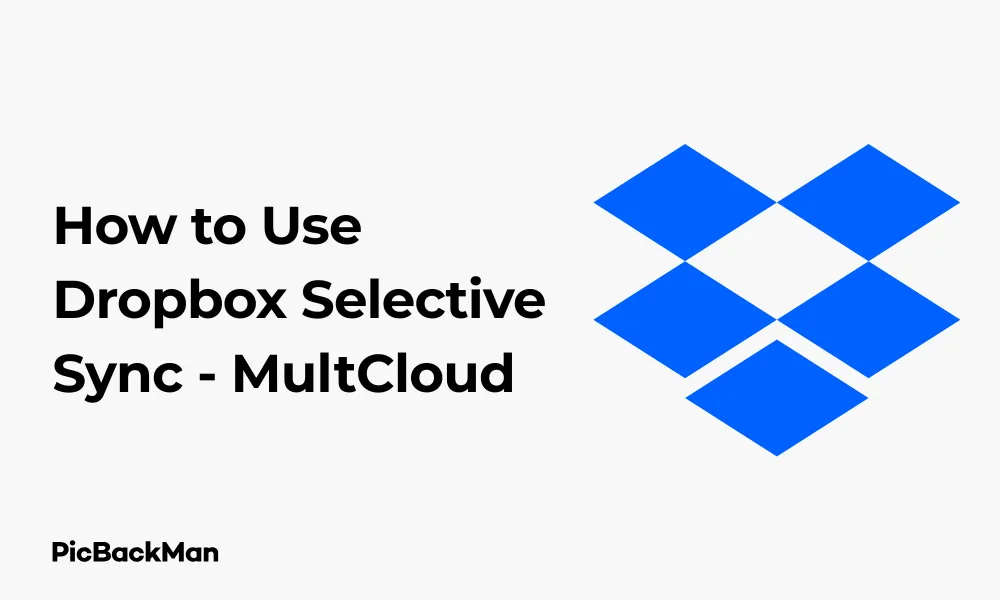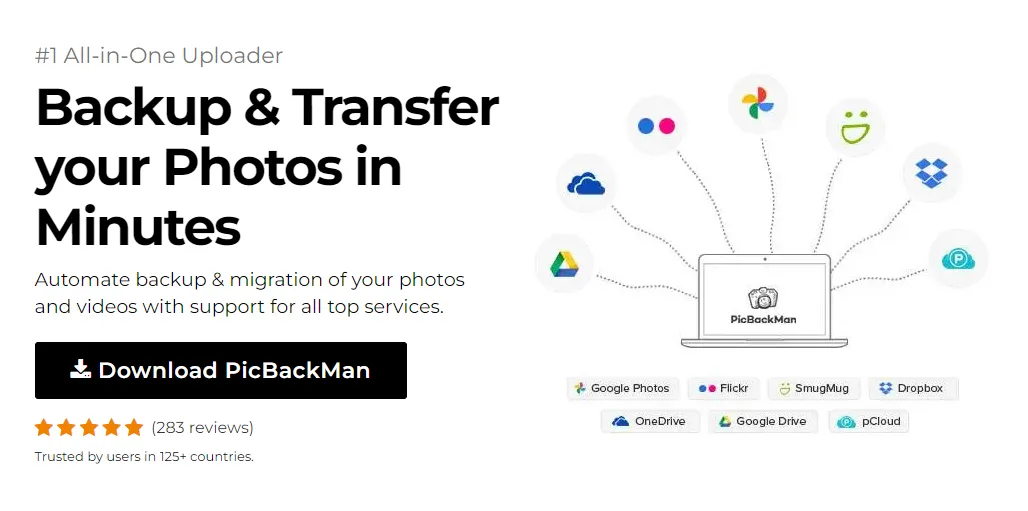
Why is it the #1 bulk uploader?
- Insanely fast!
- Maintains folder structure.
- 100% automated upload.
- Supports RAW files.
- Privacy default.
How can you get started?
Download PicBackMan and start free, then upgrade to annual or lifetime plan as per your needs. Join 100,000+ users who trust PicBackMan for keeping their precious memories safe in multiple online accounts.
“Your pictures are scattered. PicBackMan helps you bring order to your digital memories.”
How to Use Dropbox Selective Sync - MultCloud


Managing your cloud storage efficiently is essential in today's digital world. If you use Dropbox but want to save space on your device, Dropbox Selective Sync is a feature you need to master. Even better, with tools like MultCloud, you can take your cloud management to the next level. This guide will walk you through everything you need to know about using Dropbox Selective Sync and how MultCloud can enhance your experience.
What is Dropbox Selective Sync?
Dropbox Selective Sync allows you to choose which folders from your Dropbox account sync to your computer. Instead of downloading everything to your local device, you can pick specific folders to save space while keeping everything accessible in the cloud.
This feature is particularly helpful if you:
- Have limited storage space on your computer
- Work with large files that you don't need constant access to
- Want to speed up syncing by reducing the amount of data transferred
- Need to manage multiple Dropbox accounts
Basic Dropbox Selective Sync Setup
Before we explore MultCloud integration, let's make sure you know how to use Dropbox's built-in Selective Sync feature:
For Windows Users
- Click the Dropbox icon in your system tray
- Click your profile picture or initials
- Select "Preferences"
- Go to the "Sync" tab
- Click "Selective Sync"
- Uncheck folders you don't want on your local device
- Click "Update" to apply changes
For Mac Users
- Click the Dropbox icon in the menu bar
- Click your profile picture or initials
- Select "Preferences"
- Go to the "Sync" tab
- Click "Selective Sync"
- Uncheck folders you don't want on your local device
- Click "Update" to apply changes
What is MultCloud?
MultCloud is a cloud management service that allows you to manage multiple cloud storage accounts in one place. Instead of switching between different cloud services, MultCloud provides a unified interface where you can transfer, sync, and manage files across platforms like Dropbox, Google Drive, OneDrive, and many others.
Key features of MultCloud include:
- Cloud Transfer: Move files between different cloud storage services
- Cloud Sync: Set up automatic synchronization between cloud accounts
- Cloud Explorer: Browse and manage files across all your cloud storage
- Team Transfer: Share cloud files with team members
- Remote Upload: Download files from URLs directly to your cloud storage
Setting Up MultCloud for Dropbox Management
To get started with MultCloud and enhance your Dropbox Selective Sync experience, follow these steps:
Step 1: Create a MultCloud Account
- Go to www.multcloud.com
- Click "Sign Up" in the top-right corner
- Enter your email address and create a password
- Verify your email address to activate your account
Step 2: Add Your Dropbox Account to MultCloud
- Log in to your MultCloud account
- Click "Add Cloud" on the main dashboard
- Select "Dropbox" from the list of cloud services
- Follow the authorization prompts to connect your Dropbox account
- Grant MultCloud permission to access your Dropbox
- Name your Dropbox connection (useful if you plan to add multiple Dropbox accounts)
- Click "Add Dropbox Account"
Step 3: Explore Your Dropbox Files in MultCloud
- Once added, your Dropbox account will appear in the left sidebar
- Click on it to browse all your Dropbox files and folders
- You can now manage your Dropbox content directly from MultCloud
Using MultCloud with Dropbox Selective Sync
Now that you have both Dropbox Selective Sync and MultCloud set up, let's explore how to use them together effectively:
Method 1: Cloud Sync for Enhanced Selective Sync
MultCloud's Cloud Sync feature takes Selective Sync to the next level by allowing you to sync specific folders between different cloud services or even between different Dropbox accounts.
- In MultCloud, click "Cloud Sync" from the top menu
- Select your Dropbox folder as the source
- Choose a destination (another cloud service or a different Dropbox account)
- Select sync options:
- One-way sync: Changes in source reflect in destination
- Two-way sync: Changes in either location reflect in both
- Real-time sync: Changes sync immediately
- Click "Sync Now" to start the process
Method 2: Using Cloud Transfer for Selective Files
If you want to move selective files between cloud services:
- In MultCloud, click "Cloud Transfer" from the top menu
- Select your source Dropbox folder
- Choose your destination folder (in any connected cloud)
- Set your transfer options:
- Filter options (by file type, size, or name)
- Schedule options (one-time or recurring transfers)
- Email notification when complete
- Click "Transfer Now" to begin
Advanced MultCloud Strategies for Dropbox Management
Strategy 1: Creating Custom Sync Rules
MultCloud allows you to create detailed sync rules that go beyond Dropbox's native Selective Sync capabilities:
- Go to "Cloud Sync" in MultCloud
- Set up a new sync task between your desired locations
- Click "Options" before starting the sync
- Under "Filter", you can:
- Include only specific file types (eg, .jpg, .pdf)
- Exclude certain file types
- Set file size limitations
- Include or exclude files with specific names or patterns
- Save your settings and run the sync
Strategy 2: Scheduled Syncs for Automated Management
Set up scheduled syncs to automatically manage your Dropbox files:
- Create a new Cloud Sync task in MultCloud
- Configure your source and destination
- Click "Schedule"
- Choose your preferred schedule:
- Daily at specific times
- Weekly on selected days
- Monthly on specific dates
- Specify exact time for sync to occur
- Enable email notifications to get updates on sync status
- Save your schedule
Strategy 3: Multi-Account Management
If you have multiple Dropbox accounts (personal and work, for example), MultCloud excels at helping you manage them:
- Add all your Dropbox accounts to MultCloud
- Use the Cloud Explorer to view files across all accounts simultaneously
- Set up syncs between specific folders in different accounts
- Transfer files directly between accounts without downloading
- Create folder structures across accounts with consistent batch operations
Comparing Dropbox Selective Sync vs. MultiCloud Sync
| Feature | Dropbox Selective Sync | MultCloud Sync |
|---|---|---|
| Cross-platform sync | No (Dropbox only) | Yes (across multiple cloud services) |
| File filtering | Folder-level only | Advanced filtering by type, size, name |
| Scheduling | Always on (no scheduling) | Customizable schedules |
| Direction | One-way only | One-way or two-way options |
| Multiple account support | No | Yes |
| Bandwidth usage | Uses your computer's connection | Cloud-to-cloud (no local bandwidth) |
Practical Use Cases for MultCloud with Dropbox
Use Case 1: Photographer Managing Large Files
If you're a photographer with limited local storage but a large Dropbox account:
- Use Dropbox Selective Sync to keep only current project folders on your computer
- Use MultCloud to automatically sync finished projects to a backup cloud service
- Set up filters to only sync edited photos (.jpg files) to client-sharing folders
- Schedule overnight transfers of RAW files to archive storage
Use Case 2: Business Team Collaboration
For business teams working across multiple cloud platforms:
- Use Dropbox Selective Sync to keep only your department's files locally
- Set up MultCloud to sync shared project folders between Dropbox and Google Drive
- Create automated syncs to share deliverables with clients on their preferred platforms
- Establish two-way syncs for collaborative folders across team members' accounts
Use Case 3: Personal and Work Account Separation
If you need to maintain separation between personal and work files:
- Use Dropbox Selective Sync to keep only personal files on your home computer
- Set up MultCloud to maintain specific work files available across both accounts
- Create scheduled one-way syncs for shared resources
- Use filtering to ensure sensitive documents never cross between accounts
Troubleshooting Common Issues
Issue 1: Sync Conflicts in MultCloud
If you encounter sync conflicts:
- Check the conflict notification in MultCloud
- Review both versions of the file
- Choose which version to keep or save both with different names
- Consider setting up one-way sync instead of two-way for folders with frequent changes
- Adjust your sync schedule to reduce simultaneous edits
Issue 2: Missing Files After Selective Sync
If files seem to disappear after using Selective Sync:
- Check your Dropbox web interface to confirm files still exist in the cloud
- Verify your Selective Sync settings to ensure you haven't unintentionally unselected folders
- In MultCloud, check your sync logs for any failed transfers
- Try refreshing your cloud connection in MultCloud
- Consider running a new sync task with detailed logging enabled
Issue 3: Slow Sync Performance
To address slow sync performance:
- Check your internet connection speed
- Reduce the number of files in each sync task by creating multiple smaller tasks
- Schedule syncs during off-peak hours
- Verify you're not hitting Dropbox API rate limits (especially with free accounts)
- Consider upgrading your MultCloud plan for better performance
Optimizing Your Workflow
Tip 1: Create a Sync Strategy
Before setting up complex sync arrangements, plan your strategy:
- Map out which folders need to be available locally vs. cloud-only
- Identify which files need to be shared across platforms
- Determine sync frequency needs for different file types
- Consider access needs when offline
- Plan folder structure for consistency across platforms
Tip 2: Use Filters Effectively
MultCloud's filtering options can dramatically improve your workflow:
- Filter by file extension to separate documents from media files
- Use size filters to keep large files in the cloud only
- Create name pattern filters for project-specific files
- Combine multiple filter rules for precise control
- Test filters with small batches before applying to large folders
Tip 3: Regular Maintenance
Keep your cloud setup running smoothly with regular maintenance:
- Review and update your Selective Sync settings quarterly
- Check MultCloud sync logs for any recurring issues
- Clean up completed or unnecessary sync tasks
- Verify all cloud connections are working properly
- Adjust your strategy as your storage needs evolve
MultCloud Free vs. Premium for Dropbox Management
| Feature | MultCloud Free | MultCloud Premium |
|---|---|---|
| Number of cloud accounts | Unlimited | Unlimited |
| Data traffic | 30GB/month | 150GB to 10TB/month (depending on plan) |
| Transfer speed | Standard | 9x faster |
| Scheduled sync/transfer | Basic | Advanced options |
| Filter options | Limited | Advanced |
| Real-time sync | No | Yes |
Security Considerations
When using MultCloud with Dropbox, security should be a priority:
Data Protection
- MultCloud uses 256-bit encryption for data transfer
- Your cloud account passwords are not stored on MultCloud servers
- OAuth authorization is used for secure access
- Consider enabling two-factor authentication on both Dropbox and MultCloud
- Regularly review connected apps in your Dropbox security settings
Privacy Practices
- Review MultCloud's privacy policy before connecting sensitive accounts
- Be selective about which folders you grant access to
- Consider creating a separate Dropbox account for MultCloud integration if handling highly sensitive data
- Use MultCloud's "offline mode" for sensitive transfers when available
Quick Tip to ensure your videos never go missing
Videos are precious memories and all of us never want to lose them to hard disk crashes or missing drives. PicBackMan is the easiest and simplest way to keep your videos safely backed up in one or more online accounts.
Simply download PicBackMan (it's free!) , register your account, connect to your online store and tell PicBackMan where your videos are - PicBackMan does the rest, automatically. It bulk uploads all videos and keeps looking for new ones and uploads those too. You don't have to ever touch it.
Conclusion
Mastering Dropbox Selective Sync with MultCloud gives you never-before-seen control over your cloud storage. You can save local disk space while maintaining access to all your files, sync across multiple cloud platforms, and automate file management tasks that would otherwise be manual and time-consuming.
The combination of Dropbox's reliable storage and MultCloud's powerful management tools creates a flexible system that can adapt to your specific needs, whether you're an individual user with multiple accounts or part of a team that uses various cloud services. By implementing the strategies outlined in this guide, you can create a streamlined, efficient cloud workflow that saves time, reduces storage concerns, and keeps your files organized across all your devices and platforms.
Remember to regularly review and adjust your sync settings as your needs change, and take advantage of MultCloud's advanced features to get the most out of your cloud storage experience. With these tools at your disposal, you'll never have to worry about storage limitations or file accessibility again.
Frequently Asked Questions
1. Does MultCloud actually store my files?
No, MultCloud doesn't store your actual files. It acts as an intermediary service that connects to your existing cloud storage accounts. Your files remain stored on their original platforms like Dropbox, Google Drive, etc. MultCloud only facilitates the transfer, sync, and management of these files between different services.
2. Will using MultCloud with Dropbox affect my storage quota?
No, using MultCloud doesn't affect your Dropbox storage quota. Since MultCloud doesn't duplicate your files but rather helps manage them, your storage usage on Dropbox remains the same. However, if you use MultCloud to copy or transfer files between services, those files will count toward the quota of each service where they're stored.
3. Can I use MultCloud to sync between personal and business Dropbox accounts?
Yes, MultCloud works perfectly for syncing between personal and business Dropbox accounts. You can add both accounts to MultCloud and set up sync tasks between specific folders. This is especially useful for maintaining separation between personal and work files while still having access to what you need across accounts.
4. What happens if I exceed MultCloud's free data traffic limit?
If you exceed the 30GB monthly data traffic limit on MultCloud's free plan, your transfers will pause until the next month when your quota resets. You won't lose any data, but ongoing syncs will be interrupted. To continue using the service without interruption, you would need to upgrade to a premium plan with higher data traffic allowances.
5. Is there a way to test MultCloud's premium features before purchasing?
Yes, MultCloud occasionally offers trial periods for their premium features. You can check their website for current promotions or contact their customer support to inquire about trial options. They sometimes provide limited-time access to premium features so you can test the advanced functionality before committing to a paid plan.






